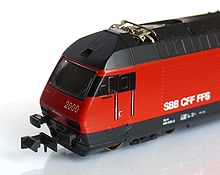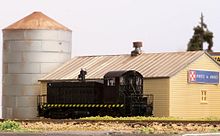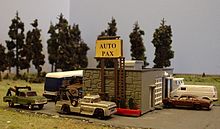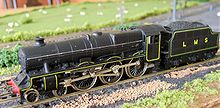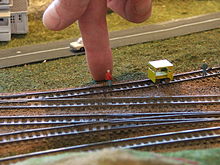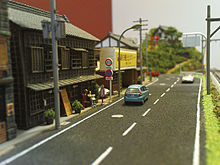- N scale
-
This article is about the model railway track size. For the handheld video game system/mobile telephone, see N-Gage.
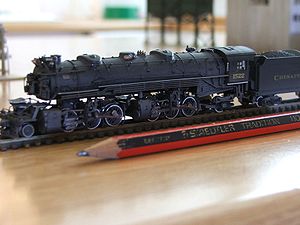 U.S. Prototype model of an N scale (1:160) Chesapeake and Ohio Railway 2-6-6-2 Mallèt shown with a pencil for size
U.S. Prototype model of an N scale (1:160) Chesapeake and Ohio Railway 2-6-6-2 Mallèt shown with a pencil for size
N scale is a popular model railway scale/track gauge. Depending upon the manufacturer (or country), the scale ranges from 1:148 to 1:160. In all cases, the gauge (the distance between the rails) is 9 mm (0.354 in). The term N gauge refers to the track dimensions, but in the UK in particular N gauge refers to a 1:148 scale with 9 mm (0.354 in) track gauge modelling. The terms N scale and N gauge are often used interchangeably. An advantage of N scale is that it allows hobbyists to build layouts that take up less space than HO scale, or put longer track runs into the same amount of space, because the models are smaller (by nearly a half) than they are in HO scale (1:87). While N scale is quite small, it is not the smallest commercially available scale, as Z scale is smaller yet at 1:220 and T scale is 1:450 or 1:480.
N scale is considered generally compatible with 1:144 scale for miniature wargaming.
Contents
History
Although trains and accessories of similar gauge and/or scale existed as early as 1927, modern commercially produced N scale models were first launched by the Arnold company of Nuremberg in 1962. Unlike other scales and gauges, which were de facto standards at best, within two years N scale manufacturers defined the gauge, voltage, as well as the height and type of couplers. For example Arnold developed the now ubiquitous "Rapido" coupler to provide a simple and robust releasable coupler design. Although the original Arnold coupler has been joined by more functional and aesthetically pleasing designs (see discussion below), Arnold allowed use of the Rapido design by other manufacturers and so established a common standard to couple together rolling stock from different sources[citation needed].
N scale has a large worldwide following. Models are made of very many standard gauge prototypes from every continent. N scale's popularity is second only to HO scale's. In Japan, where space in homes is more limited, N scale is the most popular scale, and HO scale is considered large. Not all modellers select N because they have small spaces; some use N scale in order to build more complex or more visually expansive models.
N scale in Australia has become more popular over the years. Modellers model mainly US, British and European prototypes because until recently the Australian market had no N scale models of local prototype. The creation of local prototypes is now a flourishing "cottage" industry, making Australia N scale modelling more popular each year.
N gauge track and components are also used with larger scales, in particular HOe and OO9 scale for modelling narrow gauge railways. N scale models on Z scale track are used to model metre gauge (Nn3). A small amount of 2' industrial narrow gauge modelling in N scale using custom track is done but there are few suppliers of parts. Nn18 layouts use T scale track and mechanisms to represent minimum gauge railways. N scale trains and structures are often used on HO or larger layouts to create forced perspective, or the illusion that an object is further away than it actually is.
Standards
Standards useful to both manufacturers and modellers are maintained by MOROP in Europe and the NMRA in North America. These standards are generally the same for such elements as track gauge, scale ratio, couplings, and electrical power and differ for clearances and other factors that are specific to the prototype being modelled. The wheel and track standards are however slightly incompatible and most vendors follow neither standard in part because of this.
N scale locomotives are powered by DC motors which accept a maximum of 12 V DC. In traditional DC control, the speed of the train is determined by the amount of voltage supplied to the rails. The direction of the train is determined by the polarity of the power to the rails. Since the end of the 20th century, an increasing number of enthusiasts have started using digital train control systems to determine the speed and direction of their trains. This has in part been made possible by surface mount technology and new motors that draw very little current (typically 0.2amps). The most popular digital control systems used in N scale model railways are NMRA-DCC and Selectrix.
The initial agreed-to standard coupling was known as a 'Rapido' coupler from the manufacturer (Arnold); this coupler had been produced under a license from TT-manufacturer Rokal. Most companies developed their own variants of this coupler to avoid Arnold patents on the spring system. Graham Farish initially adopted a plastic flexible U rather than a spring, Peco used a compatible weighted coupler system (Elsie) and Fleischmann cunningly sidestepped the problem by using a sprung plate. All however were compatible.
The Rapido coupler system works well but is difficult to use for automatic uncoupling and also relatively large. In the U.S., Canada and Australia it has been largely superseded by a more realistic looking magnetic knuckle coupler, originally made by Micro-Trains. The MT couplers (as they are known) are more delicate and closer to scale North American appearance than Rapido couplers. Also, they can be opened by a magnet placed under the track. Other manufacturers, such as Atlas and Kato, are now making couplers that mate with Micro Trains couplers.
European modellers have the option to convert the couplings on their rolling stock to the Fleischmann Profi-Coupler system for more reliable operation should they wish to do so, but most N scale rolling stock continues to be manufactured with Rapido couplers - a design which is fairly robust and easy to mold. Modern N scale stock uses a standard NEM socket for couplers which allows different coupling designs to be used by simply pulling out the old coupler and fitting a new one of a different design. In the United Kingdom vendors are increasingly shipping both NEM sockets for couplers and buckeye (knuckle) couplers.
Variants
In the United States and Europe, models of standard gauge (1,435 mm/4 ft 8 1⁄2 in) trains are built to 1:160 scale and made so that they run on N gauge track, but in some other countries changes are made. Finescale modellers also use variants of normal N scale.
In the United Kingdom a scale of 1:148 is used for commercially produced models. In Japan, a scale of 1:150 is used for the models of 3 ft 6 in (1,067 mm) and 4 ft 6 in (1,372 mm) in gauge trains, while a scale of 1:160 is used for models of standard gauge Shinkansen (Bullet Train) models. In the U.S. and Europe, a scale of 1:160 is used for models of trains, irrespective of the gauge of the real trains they are scaled from. All of these scales run on the same 9 mm (0.354 in) track gauge (N gauge). This means the track is a little too narrow for 1:148/1:150 but the difference is usually considered too small to matter. Strict 2 mm fine scale modellers use slightly wider and usually hand built track.
In Britain, some N scale models are built to "2 mm scale" for "2 mm to the foot" which calculates to a 1:152 proportion. Early N scale was also known as "OOO" or "Treble-O" in reference to O and OO and was also 1:152, though for an entirely different reason.
2 mm scale
A number of modellers in the United Kingdom use 2 mm scale, a closer-to-scale standard than N scale. 2 mm scale, as the name implies, is scaled at 2 mm to the foot (1:152) with a 9.42 mm (0.371 in) track gauge. Nearer to scale appearance is achieved by finer rail, flange and crossing dimensions than commercial N gauge (9 mm/0.354 in) components. A variation of the 2 mm standards is used by the FiNe group for 1:160 scale. It uses the same rail, flange and crossing dimensions as 2 mm (1:152) standards, but with a track gauge of 8.97 mm (0.353 in), and corresponding reduction in back-to-back. FiNe is dominated by European modellers.
OOO models
In 1961 Lone Star introduced some of the very first (1:160) N scale models branded as Treble-0-Lectric (OOO) into the United Kingdom. The original die-cast metal models were push along and gauged to run on a die-cast trackwork having a gauge that was closer to 8 mm (0.315 in). Coupling was via a simple loop and pin arrangement. The novelty of the "Lone Star Locos" line was such that they even found their way to the United States and were sold in the toys area of major department stores like J.J. Newberry.
Electrified models followed soon after. The track gauge was widened to a nominal 9 mm (0.354 in) and rails were isolated with non-conductive (sleepers) for DC operation. A different coupling based on a shrunken OO scale coupling was fitted. The OOO couplings and specifications have long since been replaced by commercial N scale manufacturers.
Australian N Scale
Australian Railways have many gauges across the many states, such as 4'8 1/2" for New South Wales. Victoria's primary gauge is 5'3" with Queensland on the narrow with 3'6". Regardless of what gauge is modeled the track always remains the same at 9mm. Some very fine models are starting to emerge from various Australian manufacturers with many kits available and slip on bodies for existing mechanisms such as Kato and Bachmann. This appears to be changing with the arrival of some new productions, one notably arriving from Australia-N Railways. The first of the models being an 81 Class locomotive that is designed and built from the ground up as a true scale model of the prototype.
Japanese N scale
Since former Japanese National Railway and other major private railways adopted track gauge of 1067mm(3'6"), Major Japanese N scale models adopted 1:150 with 9mm gauge. But, in the case of Shinkansen which adopted 1435mm of track gauge, so models of Shinkansen are scaled down to 1:160. Recently a small number of modelers adopted a model scale of 1:120 with using 9mm gauge tracks to represent the narrow gauge railway 3 ft 6 in (1,067 mm) gauge lines common in Japan. This is a different prototype gauge and scale to standard N scale with the narrower prototype gauge and called as TT-gauge.
Notable layouts
- German Wolfgang Frey started to build an N-scale layout of the Stuttgart main railway station in 1978. Thirty years later the project had reached a respectable size of more than 750 square metres (8,072.9 sq ft). Mr Frey's "Stuttgart Hbf" layout is an exact replica of the Stuttgart main railway station with its related railyards in the 1970s. The layout is based on extensive background research of the protype. The layout is computer controlled by 27 PCs running software developed by the owner of the layout and features very detailed and prototypical signalling systems. The layout is private, but has an informational website in German language.
- One of the largest N scale layouts in the world is located at the San Diego Model Railroad Museum. Pacific Desert Lines [1] is a 1,200-square-foot (111.5 m2) layout featuring hand laid code 40 rail. Each piece of rail is 0.040 inches (1.016 mm) (forty thousandths) high and is manually affixed to the roadbed by solder to copper clad ties placed every 5th tie. There is approximately 33 miles (53 km) (scale miles, actually 1,089 feet / 331.9 metres) of mainline track on this massive layout as well as over 500 hand made turnouts. Many models of local San Diego structures can be identified on the layout, including an intricate scale model of San Diego's Santa Fe Depot,[2] the Western Metal Supply Building, the Carriso Gorge's Goat Canyon Trestle,[3] Palomar Observatory, the American Agar building, and the Carlsbad, California flower fields and power plant. The model of the Santa Fe depot was constructed using the actual building's blueprints and has been featured on the cover of Model Railroader magazine. The Spanish revival architecture is reproduced using epoxy castings of scale model adobe roof tiles. The Western Metal Supply Building (now part of the left field foul line in the San Diego Padres' Petco Park) was constructed using historic photographs and contains brick castings, brass-etched fire escapes, and computer-generated window panes. The detail on the Goat Canyon Trestle includes the prototype's railings, catwalks, and fire suppression system. The power plant contains fibre optic strobe lights in its chimney. Many buildings have detailed interiors, right down to the napkin dispenser and placemats on the tables at the corner cafe. Some surfers appear in the water off the coast. The layout can be operated by manual or computer control. Trains can run completely unattended or a single operator can control the layout with the click of a mouse.
- In the United States, a landmark N scale project layout, the Clinchfield, was built in 1978 by the late Gordon Odegard and featured in a series of articles for Model Railroader magazine. The article series was also reprinted in the book Modelling the Clinchfield in N Scale by Kalmbach Publishing. The Clinchfield layout measured 6 by 13 feet (1.83 by 3.96 m) and was noteworthy for a number of reasons: 1) it was highly portable because of its modular construction, 2) showed the potential of high scenery to track ratios possible in 1:160, 3) used a unique aluminum frame and (at the time revolutionary) styrofoam construction to cut down on weight and 4) was highly prototypical for the era. The Clinchfield layout is one of the most famous American N scale layouts ever constructed and was awarded as the grand prize in a 1984 sweepstakes. The layout was also displayed at a number of train shows and has traded ownership several times by private collectors. The prototype Clinchfield Railroad was an operating and holding company for the Carolina, Clinchfield and Ohio Railway. The layout has been refurbished, outfitted for DCC, and was shown at the 2008 N Scale Collectors National Convention in Louisville, KY.
- Also in the United States, a massive N scale semi-public layout, entitled East valley Lines, is in Los Angeles, California. It is maintained by a semi-public special club and is part of Griffith Park.
See also
Manufacturers
- Australia-N Railways Quality Australian Locomotives, Carraiges, and line side structures in Australian Outline.
- Arnold
- Athearn Produces U.S. prototype locomotive and freight cars
- Atlas Model Railroad Co Highly regarded manufacturer of U.S. N scale locomotives, track, freight cars, and more
- BLMA Models. Fine-Scale Locomotive, Freight Car & Scenery Accessories
- CJM Models. Specialists In Modern 'N' Gauge - Bepsoke and highly sought after models.
- Dapol Maker of British outline model trains
- DeLuxe Innovations. Freight Cars, Containers/Trailers, Structures & Accessories
- Fleischmann (model railroads) German maker of model trains
- Graham Farish Maker of British model trains
- Guarniero Maker of Dutch and French railway models
- Kato Japan Maker of Japanese model trains
- Kato U.S.A. Maker of U.S. Prototype model trains
- Kawai Hobby Maker of Japanese steam model trains
- LifeLike Produces freight cars and scale locomotives.
- Lemke/Hobbytrain Maker of European N scale models
- Micro Ace Maker of Japanese model trains
- Micro-Trains Well detailed high end U.S. freight cars as well as the de facto standard for couplers
- Minitrix Part of the Trix company, owned by Märklin
- Peco Manufacturer of track, a loco and wagons, including N gauge
- PrintableKits.com An ever expanding selection of high quality downloadable N scale kits
- Roco European N scale manufacturer, N scale section now combined into Fleischmann
- Showcase Miniatures. Makers of exceptional vehicles, structures and scenery details.
- Tomix Manufacturer of Japanese model trains
- [1] Manufacturer of Taiwanese model trains.
- Wm. K. Walthers A distributor/manufacturer of model railroading products that publishes a yearly catalog. Offers a line of structures under the "Cornerstone" name as well as a limited line of N scale freight cars. Had acquired the former train lines manufactured by Life-Like in 2005.
References
International associations
- International N-Gauge Association Network
- N-Club International (in German)
- NTRAK Modular Railroading Society
- The N Scale Collector Society
National associations
- Association Française des Amis du N - France
- Associazione Nazionale Amici Scala N - Italy
- Club N de España - Spain
- N-Club Finland
- N Gauge Guild of South Africa
- N Scale Modellers Australia
- Spur-N-Schweiz - Switzerland
- The N Gauge Society - United Kingdom
- The 2mm Scale Association - United Kingdom
External links
- Australian N Scale Railways
- "1 to 160" - The European N Scale Portal (in German)
- The FiNe standards
- N Gauge Trains standards
- N Scale Limited - Tutorials and detailing articles for N scale modelers
- - A growing collection of information, tips, photographs, and projects for N scale fans
Groups
Categories:- Model railroad scales
- Scale model scales
- Miniatures games
Wikimedia Foundation. 2010.

